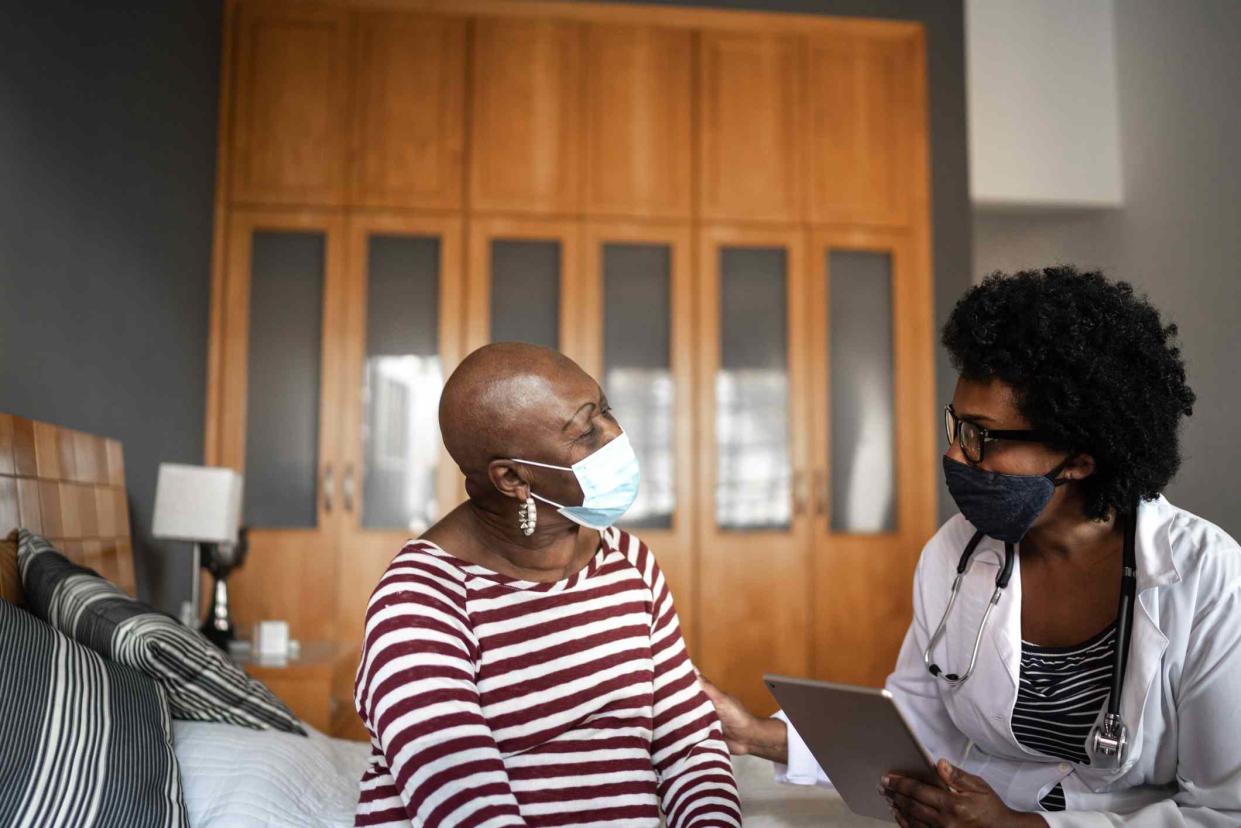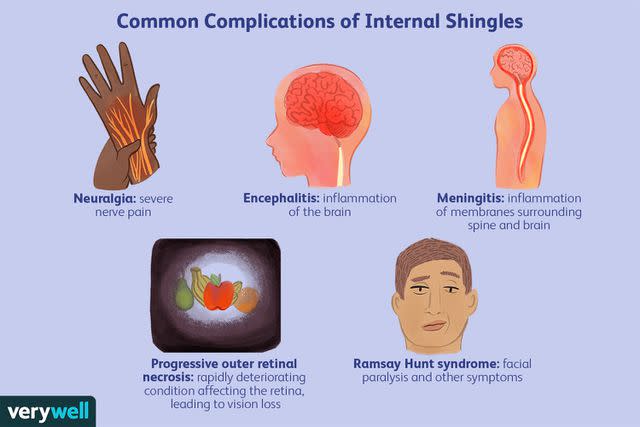Internal Shingles: Symptoms, Causes, and Treatment

FG Trade/Getty Images
Internal shingles, also known as zoster sine herpete (ZSH), is a reactivation of the varicella virus without a rash. This virus is the one that causes chickenpox, and it remains in the body even after that condition resolves.
This reactivation causes shingles, typically characterized by the development of a severe rash. However, internal shingles is particularly concerning because it doesn’t produce this rash. As such, internal shingles cases all too often go untreated, leading to the progression of the disease and serious complications.

Verywell / Jessica Olah
Possible complications include nerve pain, inflammation of the brain (encephalitis), vision problems, and Ramsay Hunt syndrome (facial paralysis and other symptoms). These problems arise as the varicella virus spreads to the nervous and other organ systems.
This article discusses internal shingles, its causes, risk factors, and symptoms. It also looks at how internal shingles is treated and prevented.
What Is Internal Shingles?
Internal shingles occurs when the virus that causes chickenpox is reactivated in the body later in life. Usually, the reactivation of this virus causes a severe rash, but with internal shingles, this rash is not present.
Symptoms
The symptoms of internal shingles are very much dependent on the bodily systems and nerves that the reactivated varicella virus spreads to. Most such relapses produce a characteristic skin rash on one side of the body or face in regular shingles cases, but they don’t do so in internal shingles.
Some of the most common symptoms of internal shingles include:
Severe nerve pain
Body aches
Fatigue
Headache
Chills and fever
Swelling of the lymph nodes
Pain and tingling from nerve injury
Causes
After you recover from chickenpox, the varicella-zoster virus remains dormant in your body. As you get older, your immune function begins to decline, which makes it possible for the virus to reactivate. This is why shingles is much more common in older adults.
It's unclear why some people develop a rash with shingles and others don't.
Risk Factors
Risk factors for developing shingles include:
Older age
Stress, both emotional and physical
Use of medications that suppress the immune system
Immunodeficiency (a weakened immune system)
Metabolic or neoplastic disorders
Infections such as AIDS or COVID-19
Is it Contagious?
You can't transmit shingles to another person, but direct contact with the fluid from a shingles rash can give chickenpox to someone who hasn't been vaccinated or has never had the disease.
It is unclear whether you can spread chickenpox if you have internal shingles.
Complications
Internal shingles can spread around your body, affecting different organs such as your eyes or your brain. When this happens, it can cause serious complications.
Preherpetic Neuralgia
One of the most striking symptoms of internal shingles is severe pain in the affected nerves. In some regular cases of shingles, this nerve pain (neuralgia) precedes the onset of rash, but in internal shingles, there is no such onset. Since this issue arises without other signs of a flare-up, diagnosis can be delayed.
This pain may be unilateral (occurring on only one side of the body), localized (in a specific area), or radial (occurring on the top of the forearm, wrist, or hand). This sensation can present either as a deeper pain in the joints and muscles or a more surface-focused burning in the skin.
While both regular shingles (herpes zoster, or HZ) and internal shingles (ZSH) can cause preherpetic neuralgia, this condition has been found to be more severe in the latter case.
One study found that at the onset of symptoms, after one month, and after three months, internal shingles patients had consistently more severe and persistent pain. Overall, however, preherpetic neuralgia occurs much more frequently in regular herpes zoster patients.
Encephalitis
If viruses spread into the brain and spine, serious issues can arise. Inflammation of the membranes surrounding the spine and brain (meningitis) and inflammation of the brain (encephalitis) are linked to both regular and internal cases of shingles.
This condition causes stiff neck, fever, and headache, with more severe cases leading to mood swings, seizures, and cognitive difficulties. If untreated, these inflammatory conditions can lead to death.
Ramsay Hunt Syndrome
This rare disorder is characterized by paralysis of the facial nerve (called palsy) and the development of rashes around the ears and mouth. Palsy causes reduced facial muscle function and can limit the ability to smile or furrow your brow. In addition, the outer ears develop a painful, reddish rash, which can also affect the inside of the mouth.
Other symptoms of this condition, caused by the spread of the varicella virus to the facial nerves and other structures in the head, include:
Tinnitus (ringing in the ear)
Otalgia (ear pain)
Hyperacusis (sounds appearing much louder than normal)
Temporary or permanent hearing loss
Nausea
Vomiting
Vertigo (persistent dizziness)
Vision Loss/Eye Problems
If the HZ virus spreads to the eyes, inflammation and damage there severely impact visual ability and can lead to blindness. Internal shingles is particularly associated with progressive outer retinal necrosis (PORN), a rapidly deteriorating condition affecting the retina in the back of the eye.
This leads to rapid reduction in the ability to see, with loss of vision starting at the periphery and moving inward.
Diagnosis
Diagnosis of conditions like internal shingles can be challenging, as many of the characteristic features of other disease manifestations are absent here. This disease is often confused for herpes simplex, scabies, or a host of other conditions, and exact identification of the pathogen is necessary. Current approaches to confirmation of a case include:
Symptom assessment: While the characteristic rash isn’t there, doctors may suspect internal shingles in cases of severe nerve pain. While symptoms can’t tell you everything, assessing them is the first step in the diagnosis. Examining medical history—especially records of previous chickenpox and/or shingles cases—is also important.
Antibody detection: The body develops antibodies in response to viral attacks. A standard approach to determining the presence of the varicella virus involves clinical testing for these antibodies. Currently, a test called enzyme-linked immunosorbent assay (ELISA) is most often employed.
DNA detection with polymerase chain reaction (PCR): This approach involves testing for varicella virus DNA within the cerebrospinal fluid, saliva, or blood. This approach is known to be very sensitive, though there is a relatively higher chance of getting a false positive.
Treatment
Shingles can't be cured, since the virus remains in your body even after your symptoms have disappeared. Treatment can help you get over your symptoms faster, however, and it can also help prevent complications. Some of these treatments include:
Antiviral medication: Your healthcare provider can prescribe medications such as Valtrex (valacyclovir) and Zovirax (acyclovir) to help combat the virus.
Non-steroidal anti-inflammatory medication (NSAIDs): Over-the-counter NSAIDs can help. If they aren't effective, your healthcare provider can prescribe stronger painkillers.
Prevention
The best way to prevent shingles is to get a shingles vaccination. This vaccination is recommended for adults who are over the age of 50 or immunocompromised.
If you do get shingles, avoid contact with anyone who is immunocompromised or has not had chickenpox or the chickenpox vaccine.
Summary
Internal shingles is shingles without the rash. Like the typical form of shingles, it is caused by reactivation of the virus that causes chickenpox. People who are older or immunocompromised are most at risk for getting shingles.
Internal shingles can cause uncomfortable symptoms like nerve pain, chills and fever, and tingling. Complications like encephalitis and vision loss may occur.
You can prevent shingles by getting a shingles vaccine.
A Word From Verywell
Shingles is no less serious, uncomfortable, or painful when it arises without the characteristic rash. What can make this disease dangerous and difficult is allowing the varicella virus to spread unchecked, something that more often happens when you have internal shingles.
The good news is that treatment options are available, with antiviral drugs such as Valtrex (valacyclovir) and Zovirax (acyclovir) leading the charge in taking on internal shingles. In addition, vaccines for the varicella virus are available and work quite well in preventing onset.
Be mindful of how you’re feeling, and if things seem awry, don’t hesitate to get help. Alongside professional medical staff, family, and friends, most are able to get the best of this debilitating condition.

